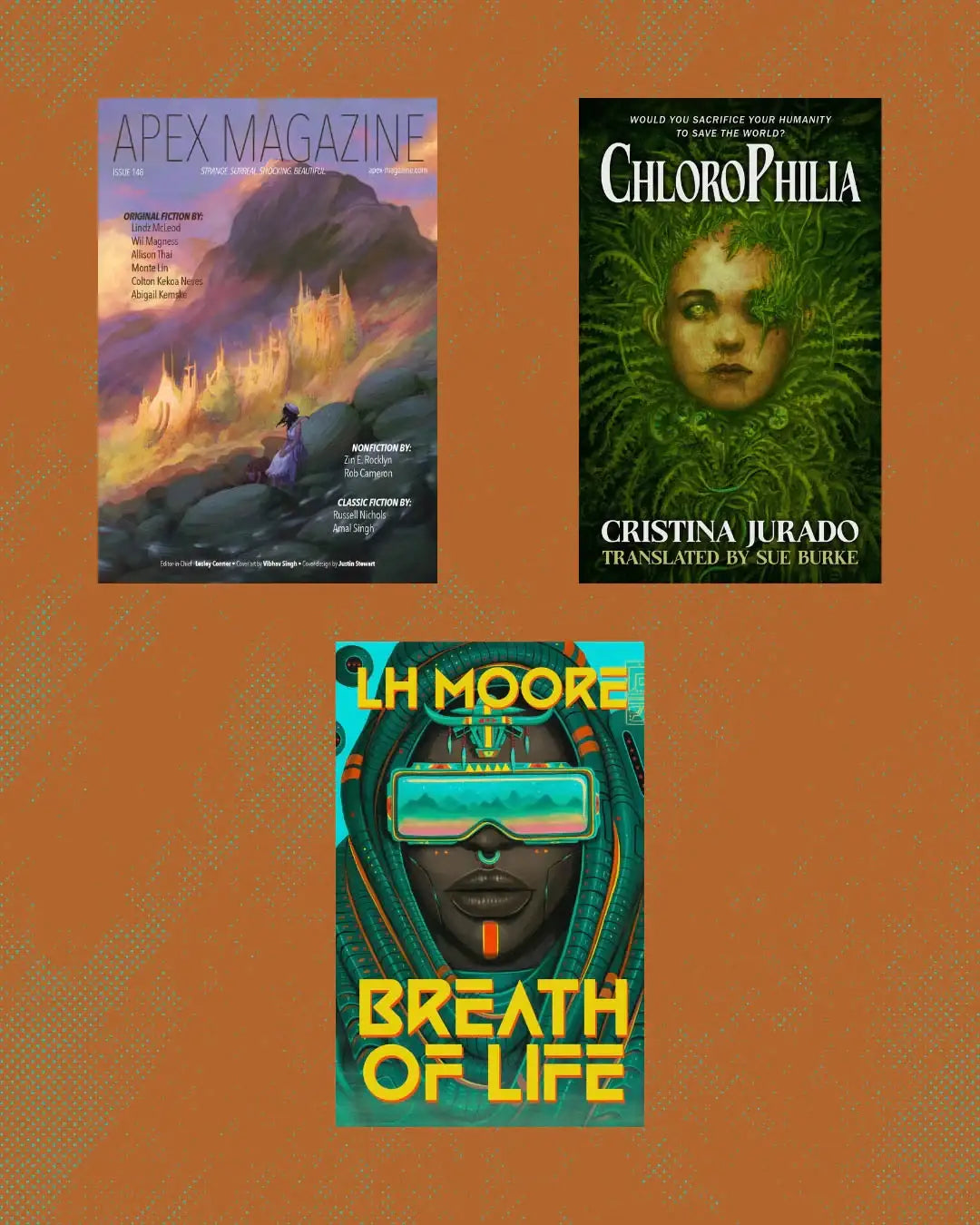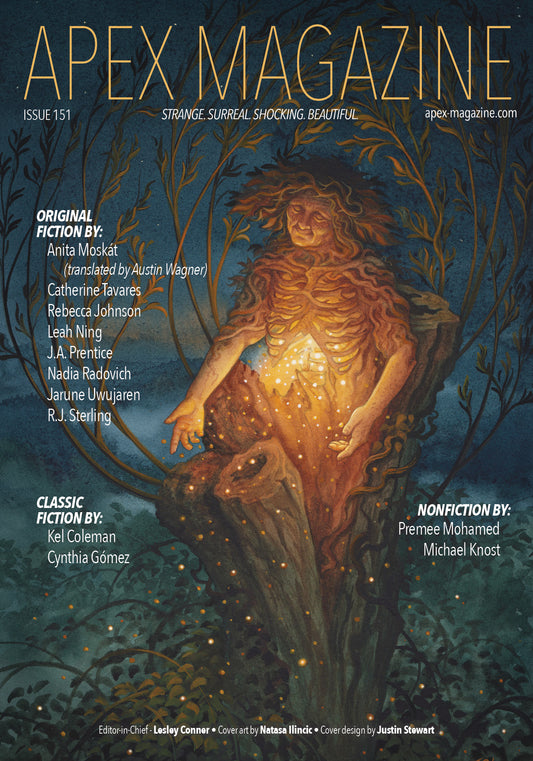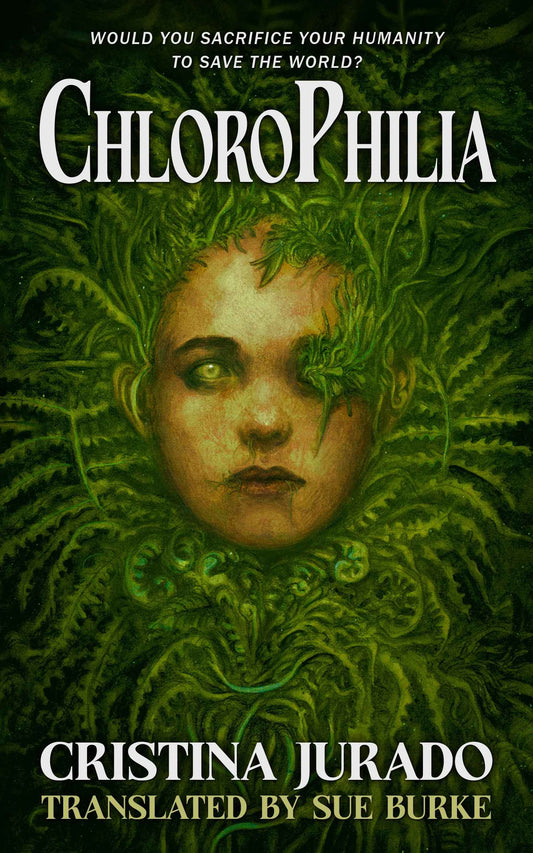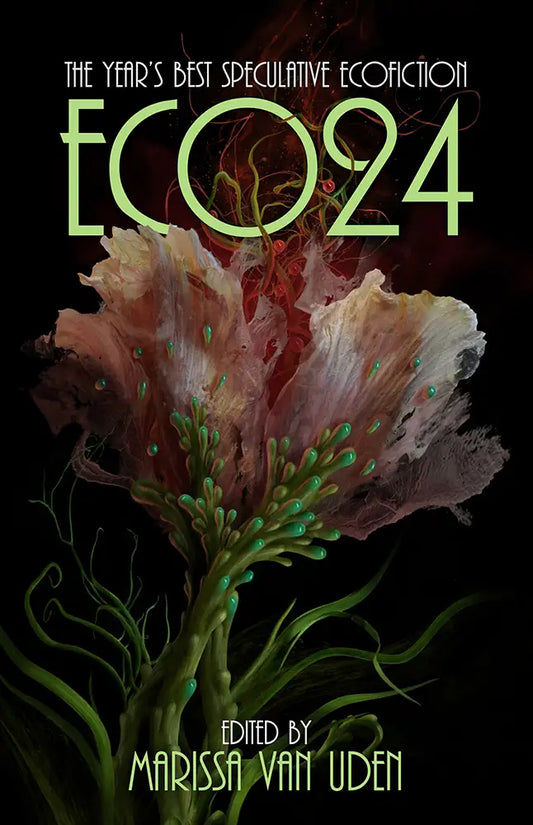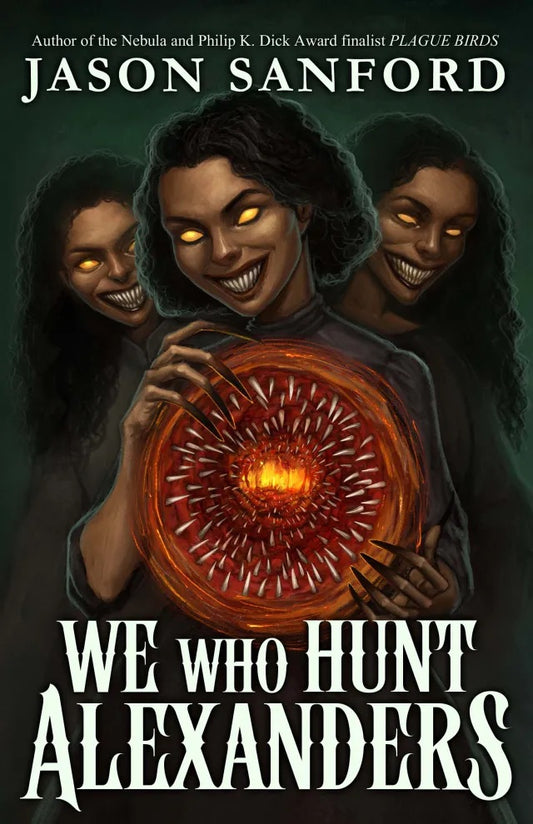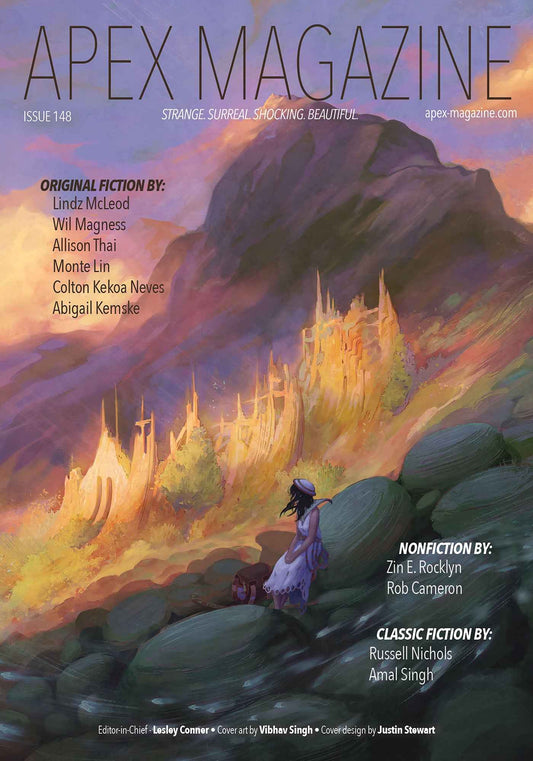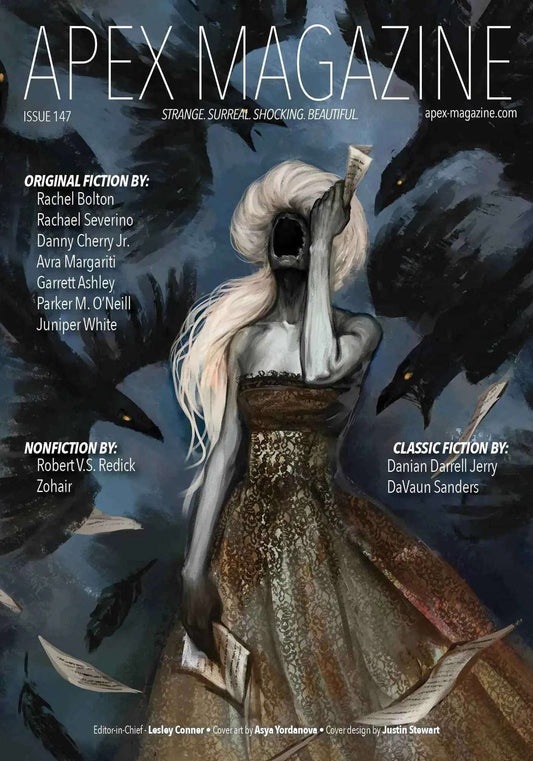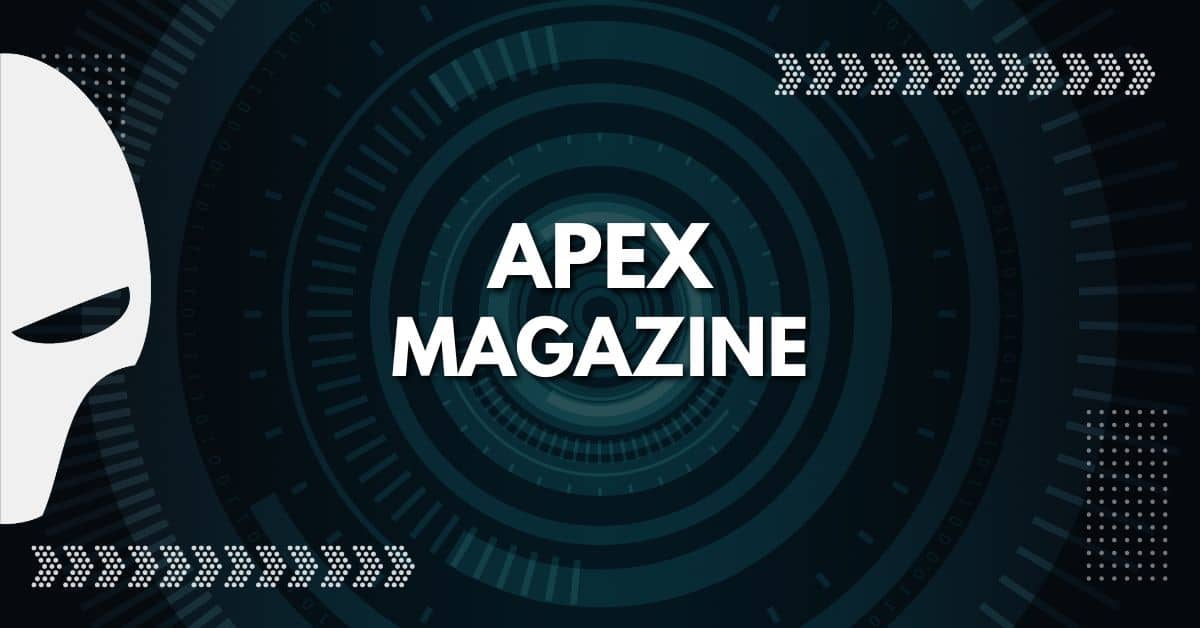
IT professional by day, writer by night, graduate of Clarion, and member of the Cajun Sushi Hamsters since she was sixteen, Marie Vibbert can tell you exactly which roller coasters she’s ridden. Her short fiction has appeared in Lightspeed Magazine, Intergalactic Medicine Show, and Escape Pod, and her poetry has appeared in Asimov’s, Eye to the Telescope, and Sanitarium Magazine.
Nearly everyone will recognize the opening conversation in “Keep Talking,” in which a parent has gotten a new job, and must convince their family that moving away from everything they know won’t be the end of the world. Subtly and elegantly layered, Vibbert handles the prickly issue of what parents choose (or are forced) to give up for their children, especially when those children have special needs. It’s a question with no answer and a million answers, and she’s handled it with a gentleness any parent or caregiver will find comfort with. Vibbert makes you comfortable, then takes a sharp left turn towards the speculative.
One question that does have an answer however, is what does a dance instructor have to do with SETI? More than you’d think. The answer to that question can be found in “Keep Talking.” Marie was kind enough to answer a few more of my questions as well, everything from researching autism, to her experiences at Clarion, to playing tackle football, to writing poetry.
Questions about the "Keep Talking":
APEX MAGAZINE: Sarah isn’t the main character of the story, but much of the story revolves around her. What was the impetus to have an autistic character in this story, and did you do any particular research to ensure her condition would be shown in a positive and realistic fashion?
MARIE VIBBERT: Actually, I always thought of her as the main character, but I’m biased by early drafts from her point of view.
I wanted to have the story revolve around two people who had trouble communicating with each other, and brainstorming different communication problems led me to autism. I’d read an article about autism being under–diagnosed in women and decided to counter that by showing a woman with autism.
Kind friends whose child has autism put up with endless questions from me and read all my drafts. (I was an absolute pest.) I also read articles online and talked to my husband, a software developer who writes for autism spectrum users.
AM: What inspired this story? Were there any particular challenges while you were writing it?
MV: I was riding home on a clear summer night, looking up at the stars and the moon, and I thought, “Wow, the light I’m seeing was emitted hundreds and thousands of years ago—what if SETI does receive a signal, but the civilization is already extinct?” The idea gave me a frisson of horror and I set out to turn it into a poem.
I never got that darn poem to work. So I wrote the idea down in my Story Ideas file. Like many things in the file, it wasn’t a story yet—it didn’t have characters.
At Clarion in 2013, when tasked to come up with a brand new short story on demand for week one, I turned to my idea file and picked this idea because I was always in love with it. In a flash I realized it needed a human relationship to juxtapose against the story of civilizations, something intimate—like a father and daughter. Even then, the story just wouldn’t work. I dropped the draft and wrote something else for week one. (“The Time Mechanic,” which came out in Intergalactic Medicine Show in September.)
It wasn’t until Andy Duncan, our first week instructor, gave a lecture on mapping a story by character interactions that I sat down, drew my character tree, realized it was a stick, and added a third main character. Miranda allowed me to add a third perspective on communication and my little idea was at last a story!
AM: While Gerald and his family are trying to come to terms with his new career opportunity, they suddenly find themselves with something much bigger to come to terms with. How do you think humanity will really react to getting a message from the stars?
MV: I’d like to think that a broader perspective would make us more aware of the fragility of our planet and our similarity with our so–called enemies, that there could be less tribalism between us when we see a world outside of us. But I think, honestly, at the time, people will still be more concerned with their own lives and struggles.
AM: I love that the aliens communicate through dance and movement (or at least that’s what we think they are doing!). How did you come up with that idea?
MV: I had a dream that became the alien dancing video. Straight dream–insertion. No credit for being smart. However the character of Miranda made me go back and make the dance and movement important. I had always intended to come up with a “non human” way for the aliens to be communicating, but I can be a bit dense, and didn’t realize the obvious choice until about draft three.
Questions about writing (and other activities):
AM: You are a graduate of the Clarion Workshop. How did you decide to apply for Clarion and how do workshops like Clarion help writers get their craft to the next level?
MV: I joined the Cajun Sushi Hamsters, a Cleveland science fiction writer’s workshop, when I was sixteen—largely due to its founder and organizer, Mary Turzillo, mistaking me for a prodigy because I told her I’d written three novels by then. (What teenager hasn’t?) Anyway, very soon after joining the Hamsters, I found that many of the members had gone to Clarion, and it sounded like HEAVEN ON EARTH. I wanted desperately to go, but I was poor. Then I was in college. Then I had a JOB. Who gets six weeks off once they have a job that pays enough to attend a six–week workshop? A few years ago, Mary’s husband Geoff Landis started really pressuring me to apply. “Go. Go to Clarion. You need to go to Clarion.” “I can’t afford it!” “Yes you can.” “I can’t take the time off.” “You won’t know if you don’t ask.”
I felt I was a has–never–been, too old to be selfishly thinking of my childhood dreams, but if a Hugo–winner like Geoff believed in me that much, I decided to give it a go. I filled out the application in a mad blur, doing it fast before I changed my mind. Then I told my boss what I’d applied for. He looked horrified. I come from a blue collar background and so does my boss—taking six weeks off and having a job to come back to is not something either of us had ever considered. But I pled that this was a life–long dream, and he said he’d talk to his boss.
Then I had to tell him I’d gotten in.
I still can’t quite believe they let me go.
SO—how does Clarion help a writer get to the next level? It doesn’t give you time to be lazy. You have to write a new story every week, while reading 17 stories every week from your cohort, and giving detailed critique and feedback. I’m not going to lie—the reading and critiquing is the real work of Clarion—writing your own stuff is a tiny fraction. Looking at stories from outside, constantly asking “How could this be better? Why does this work? Why doesn’t it?” you worry at the very problem of story itself until you see its exposed bones.
Plus my classmates were, in fact, the best people ever to attend a workshop in history. I am pretty sure that’s not biased.
AM: You’ve had quite a bit of poetry published, as well. What are the connections (if any) between writing poetry and writing short prose fiction? How do you know if a new idea will work better as a poem, or as a short story?
MV: I took a tough graduate–level poetry class and my dear friend Mary commented on a short story I wrote at the time, “Poetry has really tightened your prose!” It’s like attacking the same problem from two angles—or like alternating strength training and cardio. Poetry taught me to make every word count. (Except when I’m being lazy.) Prose introduced plot and structure to my poetry.
I used to think ideas had a fit size to them—this is a “story” idea or a “novel” idea or a “poem” idea. Not anymore. I gave myself a challenge in 2012 for the Clarion write–a–thon to write fifty short stories in six weeks. I ran out of “short story” ideas pretty fast and started turning poems and novels into short stories. I learned that any idea can fit the space you give it.
AM: How long have you been writing? Of what story (or poem) are you most proud? Which story (or poem) was the most challenging to write?
MV: Ooh, that’s a hard question to answer, because like “at what age did you start reading?” it becomes a race to zero. I’d say I really became interested in writing as a fun game to play when I was a kid. I got serious in high school when I read that Isaac Asimov (then my absolute favorite author) published his first story by age 18. I had to beat him! When I reached my 18th birthday with nothing but a short stack of novel rejections, I had the most epic emo teen meltdown you can imagine. I wasted years not submitting anything because I was “too old.”
(Repeat performances of this drama when I turned 20, 25, 30, and 35. Thankfully, at 40, I’m over it. Mostly.)
I think that “Keep Talking” was definitely my most challenging piece, both because of the subject matter, and because when I first wrote it I tried to write it in non–exclusive third person omniscient and balance all viewpoints constantly so there was no “main” character. (Clarion readers did not like that, so after swallowing my pride, I resorted to traditional limited third person.)
I’m very interested in POV, and someday I hope I can sell something with an unusual POV. I’m inordinately proud of my (unpublished) novel The Gods Awoke which is in first person omniscient.
AM: You’re a huge football fan. And a football player! In fact, you’ve been working on a novel about your experiences playing women’s tackle football. Ok, tell me everything about how you got involved with playing full contact football, and how you decided to write a book about it.
MV: Everything? Oh dear. That’s a lot. How about just how I got involved playing? It’s all my husband’s fault!
Brian had no idea he married a Browns fan until he found me one Sunday afternoon, shouting at the TV.
“How long does this go on?” he asked.
“There are two minutes until halftime,” I said.
He wandered out and came back. “Is it halftime?”
My eyes were on the action. “No. There are still two minutes to go.”
“You said that at least five minutes ago!” There was a hint of accusation in his voice.
The commercial started and I turned to face him. “Oh, honey—these are football minutes. Every football minute is like three real minutes.”
“That’s awful! You mean the hour long game takes three hours?”
“Pretty much.”
“How often are you going to be watching football?”
“Only Sundays until January.”
His shoulders drooped. “You’re going to be a lump on the couch for hours every Sunday?”
I stood up, even though a play was happening, and hugged him. “Why don’t you watch with me? It can be a couple’s activity. You’ve been saying we don’t do enough stuff together.”
“I don’t know,” he said, looking at the TV. A receiver dashed along the sideline. “It looks boring,” he said.
I didn’t process what he’d said until the receiver was pushed out of bounds. “FIRST DOWN!” I pumped my fist. Then remembered Brian. “Huh? Oh, no! It’s fascinating. It’s… it’s got character and drama. You become invested in individual athletes, you see their story—every game is a story, and the season is an over–arcing plot.”
I added, “You could make some popcorn and eat it while we watch the second half.”
My husband loves any excuse to eat popcorn.
My plan worked—Brian embraced football as a couple’s activity and an excuse to eat junk food at home. My only miscalculation was how annoying it was for me to spend the rest of that football season being interrupted every play by “Why did they do that? What’s ‘holding?’ What’s ‘pass interference?’”
The Browns did well that year—one of the few years they made the playoffs during the long dry spell after the team re–formed in 1999. I wanted to personally thank them; Brian might have been less interested if the “story” every week had a sad ending.
Some days later, Brian called me into our home office. He sat at his computer, looking excited. “So, I thought I’d write a computer game about football to help me internalize the rules. And I thought it would be cool if the characters were girls, so I did a web search for pictures of women playing football.” He was practically bouncing in his chair. “There’s a women’s football league and they have a team in Cleveland and there’s a game Saturday! Want to go?”
It only took him a minute after we were at our first Cleveland Fusion game to say, “You should totally try out!”
Brian dragged me to the tryouts, cheered me on, and has been on the sideline for me every game these past five years. I guess my plan REALLY worked.
